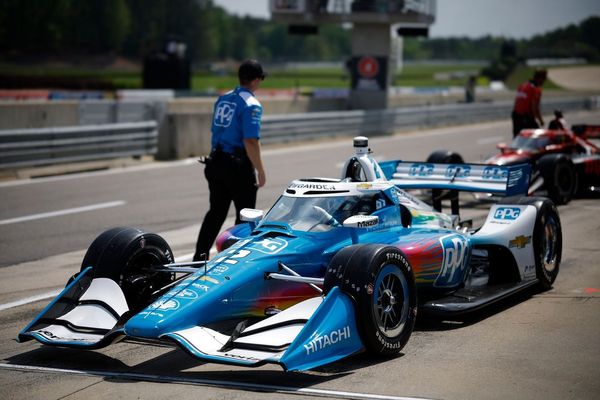When Boom Supersonic formally rolled out a subscale technology demonstrator for its supersonic Overture jetliner early this month, it cast the moment as historic – the first time a privately developed and funded supersonic aircraft emerged into the sunlight.
But bright light shines on all angles, reflecting the fact that while designing and building the aircraft, which Boom calls the XB-1, is an accomplishment, the lessons to be learned from it may be limited. Among them, it could be argued, is the lesson that the capital spent to design, build, and fly the XB-1 may have been sunken into an intermediate, unnecessary step.
That is, if R&D is Boom’s only objective for the XB-1.
Learning ROI vs. Digital Engineering
The 71-foot long, single seat, tri-engine XB-1 is one-third the scale of the 55-seat Mach 2.2 airliner that Boom aims to certify and bring to market by 2029 to 2030. The XB-1 demonstrator is slated to fly some time around the third-quarter of 2021 in Mojave, California.
A final configuration freeze for the Overture design, based partly on lessons divined from XB-1, should be made by the end of 2021 according to Boom, a notably short learning curve which will lead to the buildout of the first Overture parts and tools in 2023. The airliner will roll out in 2025 and its first flight will be in 2026.
The XB-1 is a mash-up of Boom-designed and off-the-shelf parts and systems. The critical company-designed bits from which Boom hopes to draw lessons are the demonstrator’s ogive delta wing, engine inlet design and carbon-fiber composite materials.
Along with the aircraft’s nose-section, these elements will confirm (or not) that Boom’s XB-1 will yield the projected gains in aerodynamic efficiency needed to make the larger Overture design more slippery, stable and frugal than the Concorde.
But there’s a big omission in the XB-1. It will fly with three afterburning General Electric J85 turbojet engines first designed in the 1950s and used in small tactical jets like the Northrop F-5 fighter and T-38 trainer. These may be able to push the XB-1 past the speed of sound but they are not airliner – let alone supersonic airliner – engines of contemporary design. That’s an issue since propulsion will be the single most important ingredient in making a supersonic jetliner efficient enough to operate cost-effectively.
Boom recently announced that it will partner with Rolls Royce on engines for the Overture. But for now, with the lack of production-representative propulsion, full-cabin/interior systems, and production scale elements in the XB-1, I asked Boom Supersonic founder and CEO, Blake Scholl, if Boom’s learning return on investment from the demonstrator is really worth it?
The XB-1 Scholl says, “has the same fundamental technologies that enable Overture.” Not only its aero elements but things like an augmented reality vision system for landing. The demonstrator “shows that the key technologies for supersonic flight are here and that Boom has brought them together into a successful new design,” he maintains.
Surely such technology has been here since the 1960s when Concorde, America’s aborted SST and the USSR’s Tu-144 were designed but we get the point. The company declines to say how much it’s spent on the XB-1, but Scholl says that the investment is worth it, citing lessons in everything from manufacturing processes to the development of a safety culture.
“If you learn one thing from XB-1 that saves you even just a few months on Overture, you’ve more than paid for that aircraft. We’ve done that many times over.”
He points to the fact the Concorde development adapted smaller aircraft (the Handley Page HP.115 and BAC 221) to test low-speed, transonic and high-speed envelopes and adds, “It’s hard to imagine us doing Overture successfully without everything we’ve learned from XB-1.”
But is it? The U.S. Air Force has recently extolled the virtues of digital engineering for its Next-Generation Air Dominance (NGAD) program. Dr. Will Roper, the service’s assistant secretary for acquisition, technology and logistics, has championed the capacity of digital engineering techniques to bypass the need for physical parts or systems prototypes by rendering them virtually, compressing the time and expense it takes to design, develop and field weapons.
Scholl counters that virtual studies of aircraft make it “easy to allow yourself not to solve 100 percent of the problems.” He may have a point, but Florida-based Aerion, which is developing a supersonic business jet, the AS2, in a similar time-frame to Boom, is not planning to build a demonstrator.
“We are using computer modeling/digital twin to expedite our timeline and avoid the need for expensive demonstrators,” the company said by email. “The first aircraft we build from 2023 will be production-spec, forming a flight test fleet of five AS2s.”
Teal Group analyst Richard Aboulafia thinks Aerion’s approach is reasonable given technological advances and cost constraints. “Electronic design may be making prototypes less relevant and prototypes are proving less in terms of program requirements.”
So why proceed with a one-third scale prototype that may represent one-third of the technical development that Overture will require?
Perhaps it’s to bolster Boom’s business model and to garner much needed investment.
Investment Vehicle
Among the lessons of the Concorde is that profitable supersonic transport requires a very efficient aircraft to ensure affordability and margin. In the early 1970s, aviation publication Flight International estimated the cost of operating the Concorde at $3,800 per block hour (roughly $23,662 today).
In the early 1980s a New York-London roundtrip ticket cost $4,420 ($11,550 in 2020 dollars). That wasn’t a huge premium over a contemporary first-class fare on a subsonic airliner ($3,858) but despite the flight being made in half the time, Concorde rarely flew with a full complement of 100-plus passengers.
Boom’s Overture has only 55 seats but it will have to be significantly more cost efficient than its predecessor to allow airlines to offer tickets “competitively priced with business class fares” as Scholl contends it will. It will likely have to do so on trans-Atlantic routes since its projected range is insufficient for non-stop trans-Pacific routes, blunting its speed advantage.
Developing such an aircraft will be massively expensive. Despite Boom’s success in raising $160 million in capital, it will need much, much more as Forbes has previously noted. Richard Aboulafia puts the cost in excess of $10 billion.
And when the $200 million per copy Overture does enter the market, Boom may find considerably less demand than the 1,000 t0 2,000 jets over a decade that Scholl has previously predicted. Covid-19 has certainly flipped the global air transport market but even without its impact and future uncertainty, Aboulafia opines that demand for trans-Atlantic supersonic transport is far more limited.
“The basic math was done by a guy named R.E.G. Davies in a book called Fallacies and Fantasies of Air Transport History (1994). He was one of the market analysts on Concorde. He basically said that no matter when you do it, now matter how you do it, the market is 36 aircraft.”
Davies stressed there were (and are) a very limited number of transatlantic routes that have enough full fare premium passengers to support demand. And a small fleet creates its own negative ripple effects.
“Parts and maintenance costs are based on volume,” Aboulafia says. “That’s why the [airline] industry revolves around jets like the 737 and A320. Marginal players get pushed aside.”
Whether Davies’ analysis is too pessimistic or not, Boom has a long way to go – a decade and billions in capital – to get Overture into the hands of its early investors, Japan Airlines and Virgin Atlantic. Scholl says that XB-1 moves Boom’s relationship forward with airlines, providing a tangible piece of hardware in return for their dollars.
Therein may lie its real value as a physical waypoint on the road to Overture, an enthusiasm generator to prime the investment pump. Is the XB-1 as much “investment vehicle” as test vehicle?
“You’re right,” Scholl acknowledges. “It has many purposes. It opens eyes to what is possible and what this team is capable of.”







